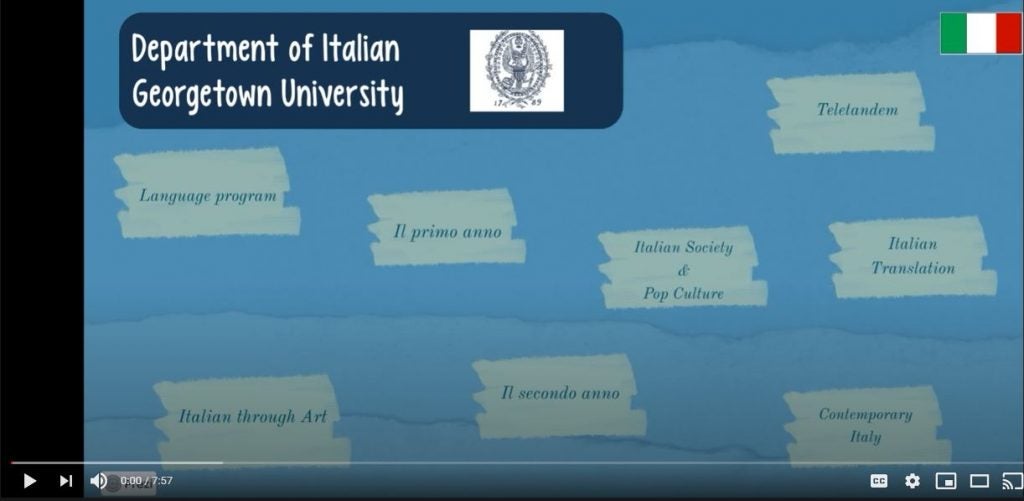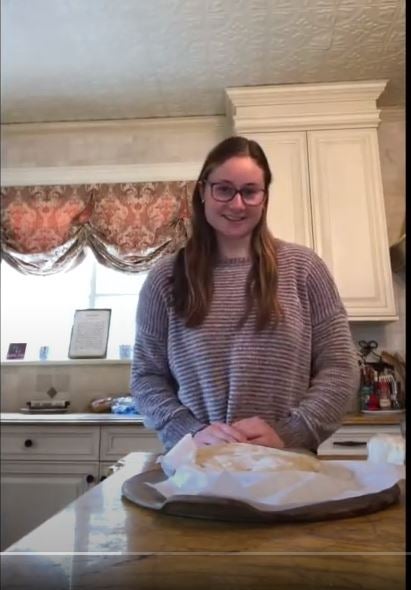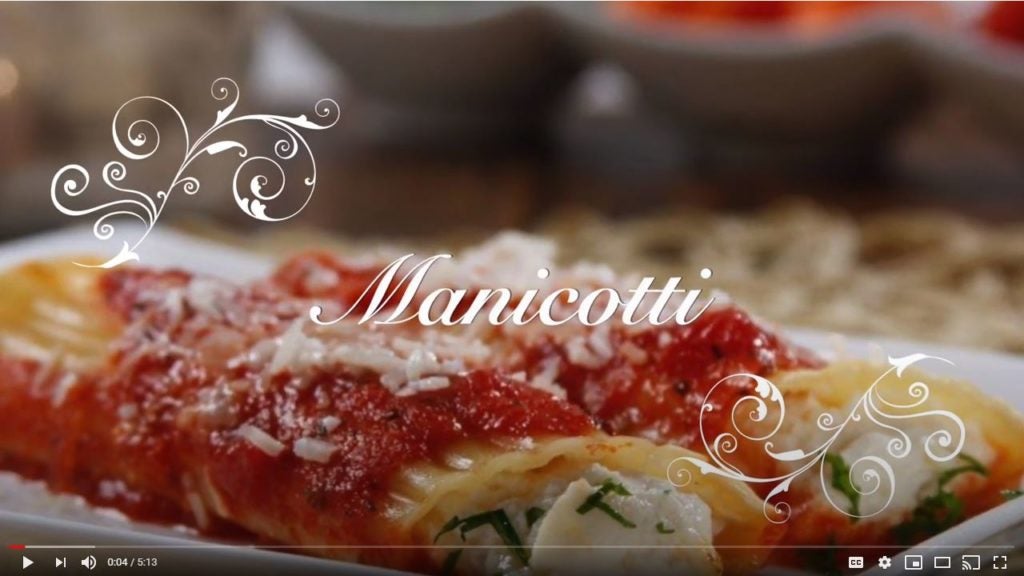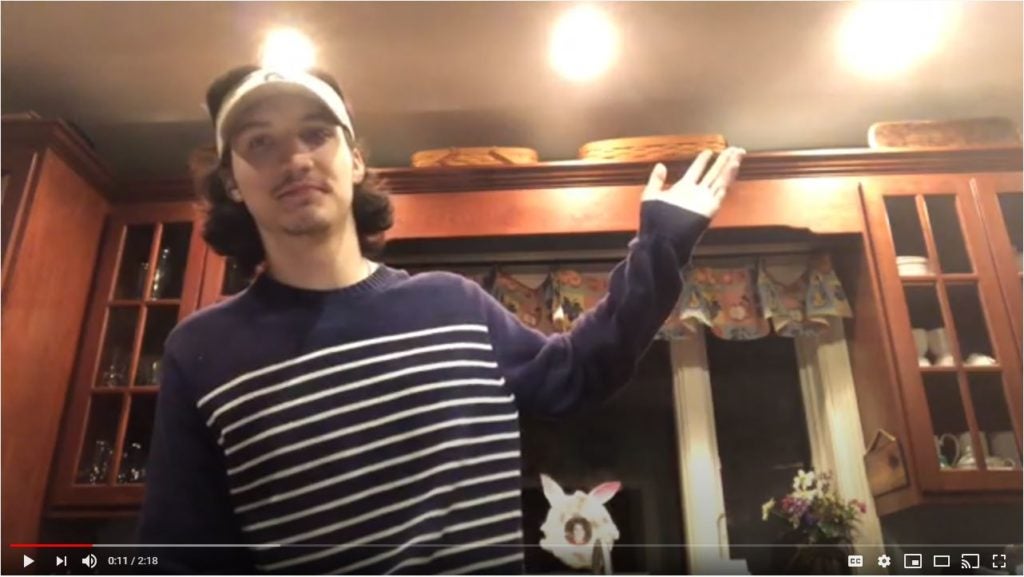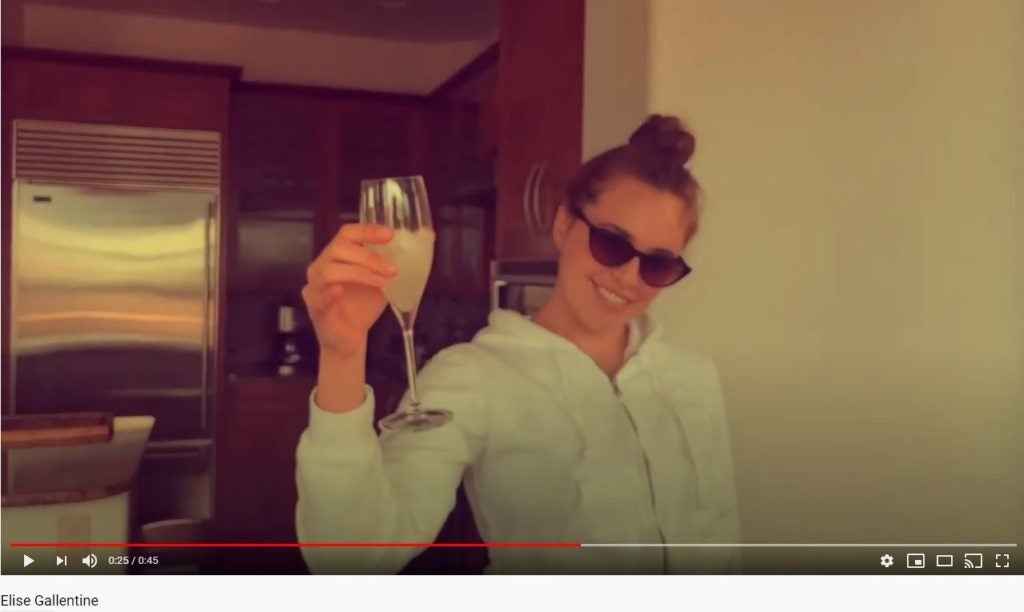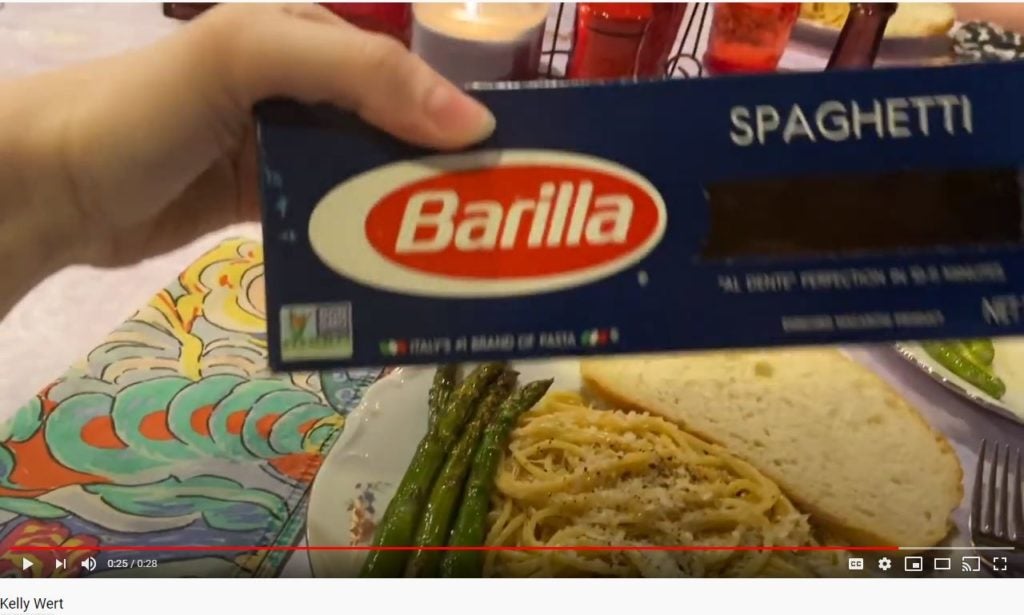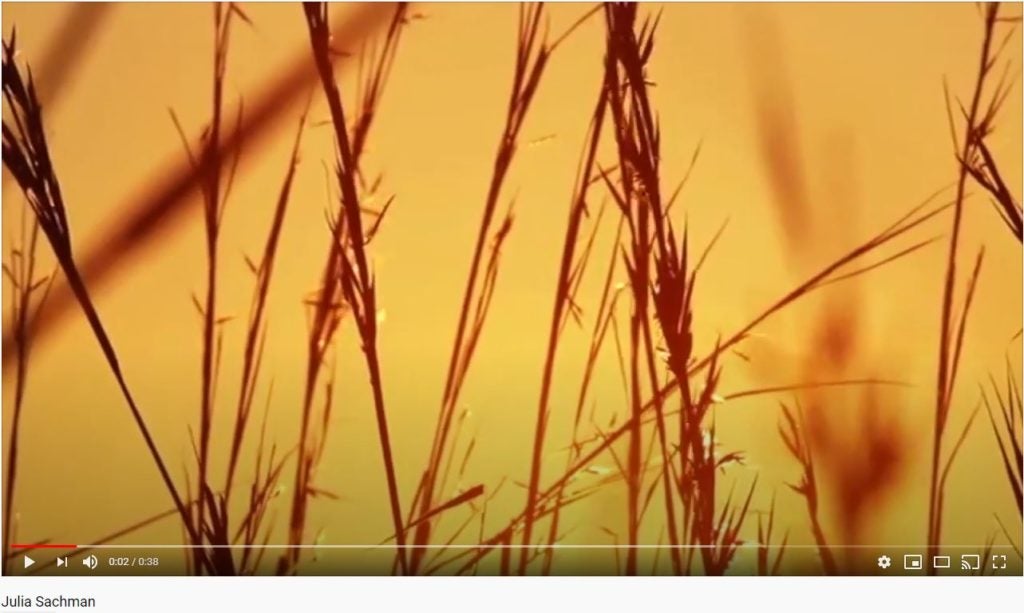Student Showcase
Beginning the 2021 academic year, the Department publishes students’ academic products in an effort to highlight their hard work and achievements.
Please find below showcases by semester, and then once again by first- and second-year divisions.
Fall 2024
Fall 2021
First-Years
The Students of Basic Italian with Professoressa Musti
Students in Prof. Essa Musti’s Basic Italian course chose their favorite Italian Recipe and made cooking “how-to” videos. She then compiled portions of all of the videos into a single format. You can view an excerpted YouTube video (without sound) below. To view this PowerPoint with sound, click the link below:
Ariana Biondi Copeland
Students choose a favorite Italian recipe and make a video of cooking it.
Malory Montgomery & Catherine Dell’Olio
Students created a brochure for their favorite Italian city or an Italian city that they would like to visit in the future.
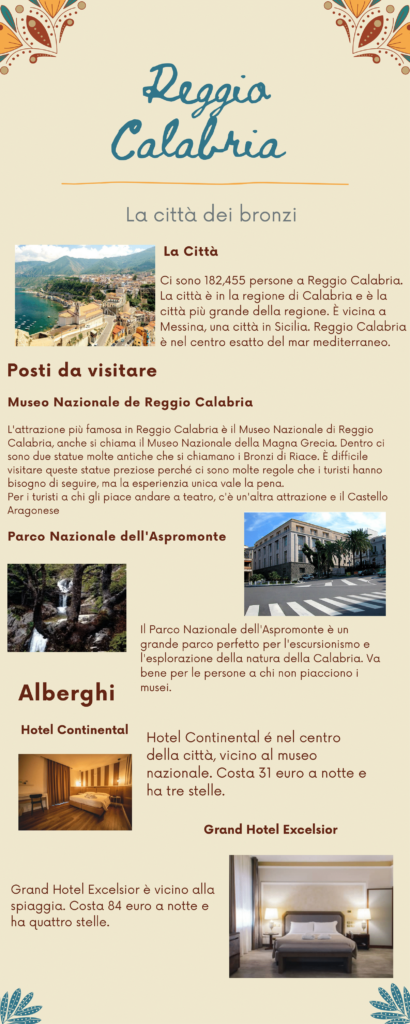
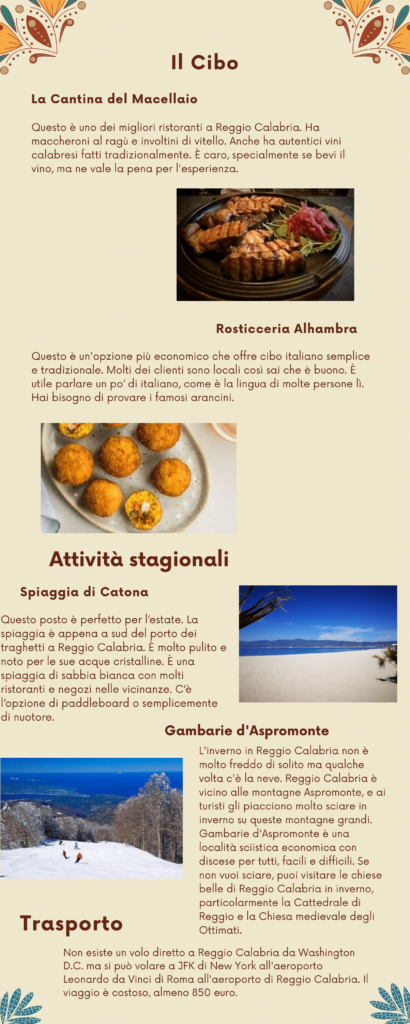
Portfolios
Students collected and reflected on their favorite assignments during the semester. This was designed to focus on language-learning techniques and experiences that had the greatest impact on their Italian studies.
Tai Markman

Cody Slutzky
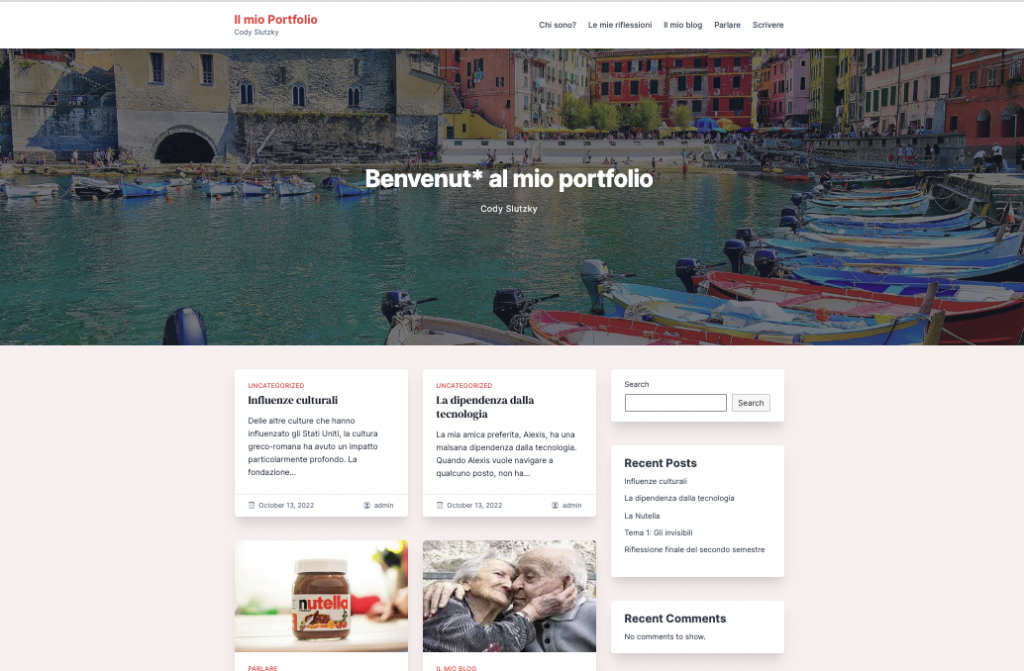
Second-Years
In Advanced 1: Italian Contemporary Culture and Society with Prof. Donatella Melucci, students develop a project about the presence and influence of Italian culture in the world, specifically in students’ lives. The following are a few examples.
Progetto: L’impronta italiana nel mondo e intorno a me
Fare una piccola ricerca sull’Impronta italiana nel mondo.
Cercate di esempi della cultura italiana nel vostro Paese e intorno a voi. Può essere un personaggio, o un esempio nelle arti o nelle scienze, oppure qualcosa di più personale come un vostro familiare o amico.
Project by Nicholas Lynch

Project by Isabella Dujarric
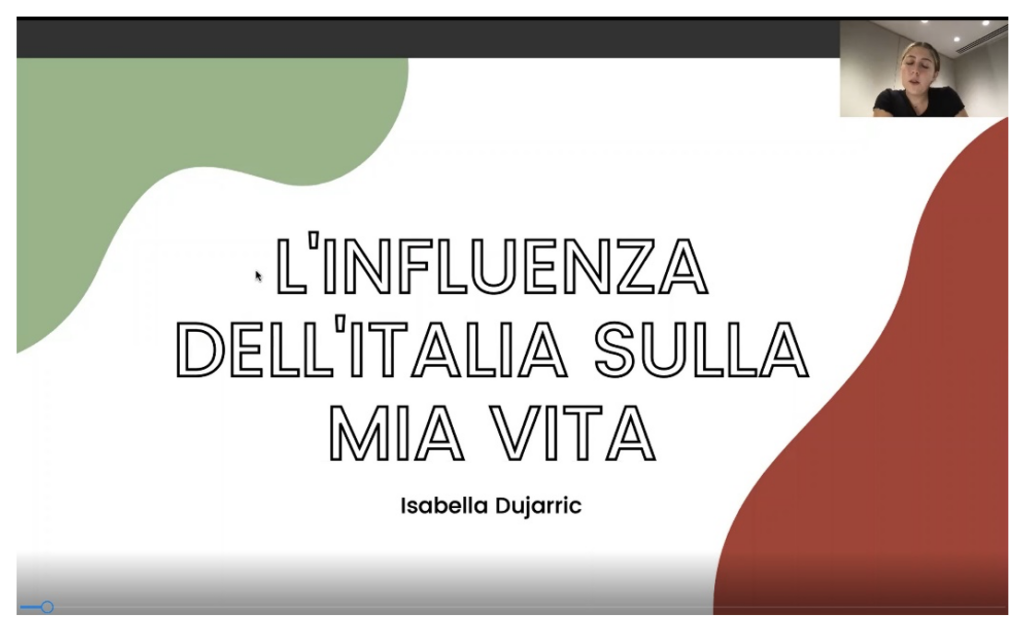
Il Mio Portfolio
These are two examples of Il Mio Portfolio projects for Advanced I:
This semester we had wonderful and enthusiastic students in both sections of Advanced II: Italian Traditions, History, and Art. As in all our language courses, we learned the Italian language and explored Italian culture. Our students developed two main projects where they could combine what they learned linguistically and culturally.
MIDTERM PROJECT: BE AN AMBASSADOR FOR AN ITALIAN REGION (OR CITY), ITS CUSTOMS, AND TRADITIONS
In the first part of the semester, we learned about Italian regions, their tradition, and customs but we also talked about how food can be the vehicle of memories.
The following is an example from Isabella Dujarric’s presentation in which she was also able to incorporate her personal experience.
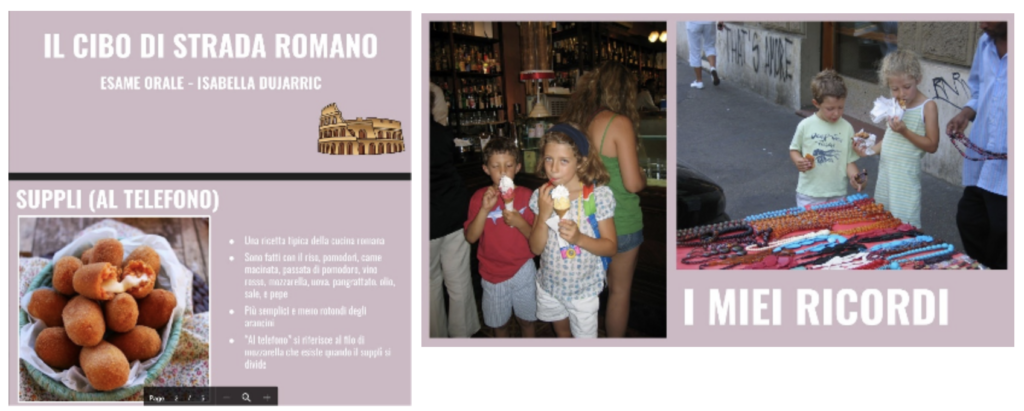
FINAL PROJECT: ITALY FROM WORLD WAR II TO TODAY
In the second part of the semester, we learned about Italian history from WWII but we also covered Italian art. Students researched and presented on a specific topic. The following is an example from Juliana St Goar’s presentation.

Il Mio Portfolio
These are two examples of Il Mio Portfolio projects for Advanced II:
ITALIAN STUDIES DURING COVID-19
Here’s a short video showcasing some of our Italian language students and their work:

Department of Italian Graduation Party for our Majors and M.A. students…on Zoom.
CONGRATULATIONS TO OUR STUDENTS!!!!!
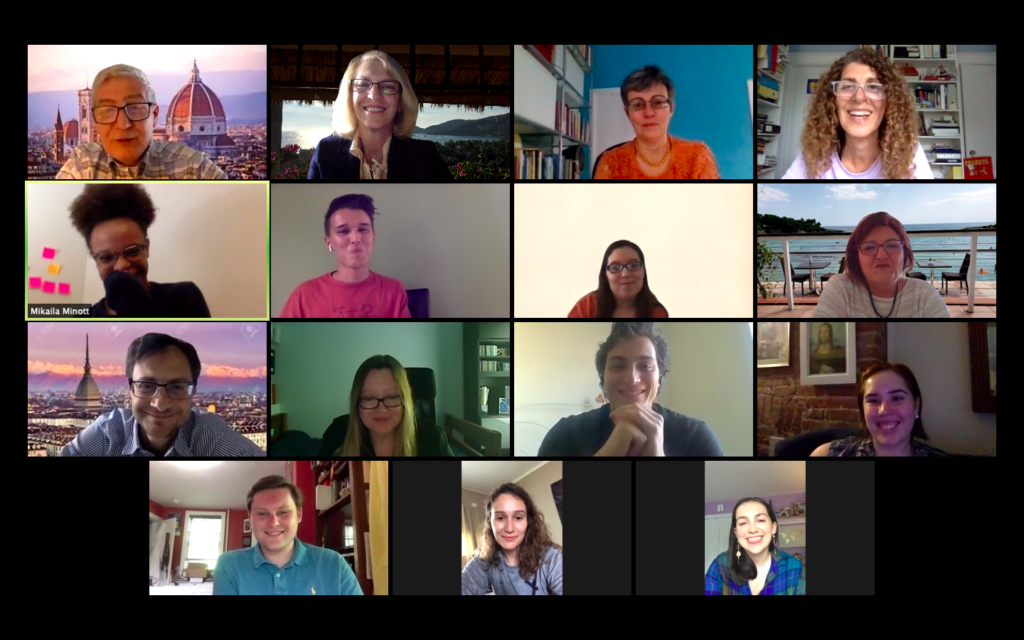
From top Left: Prof. Gianni Cicali, Prof. Anna De Fina, Prof. Laura Benedetti, Prof. Nicoletta Pireddu, Mikaila Minott (M.A.), Arthur Canonica-Babcock (Major in Italian, Honors thesis), Nikole Sanchez (M.A.), Prof. Donatella Melucci, Prof. Francesco Ciabattoni, Prof. Louise Hipwell, Zachary Penati Aguilar (M.A.), Emma Walsh (Minor in Italian), Harry Rose (Major in Italian, Honors thesis), Jordan Brewer (M.A. candidate), Rachel Grasso (M.A.).
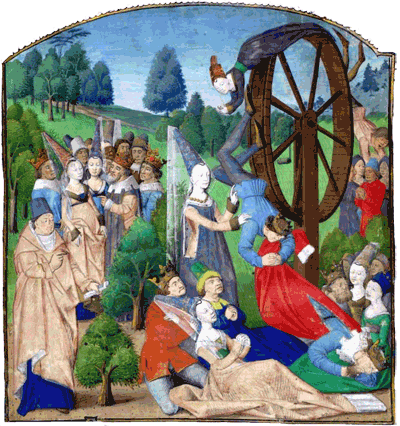
Hoyasaxon, a modern-day Decameron: an experiment in narrative healing
In Spring 2020, Professor Laura Benedetti asked her class of 10 to update Boccaccio’s classic. Read the article describing their experience here

Returning from abroad: Italian major Danielle Guida recounts her journey back from Bologna.
Click here to read the article

Intensive Intermediate with Professoressa Musti. From top left, Paige Plucker, [Instructor: Fulvia Musti], Katherine Christy, Madeline Wasson, Caitlin Frazier, Gioia Basile, Ryan Evangelista, Iyanda Channer-Newman, Joseph Cafaro, David Kroll, Rebekah Borah, Briley Thomas, David Mohler, Thomas O’Neil
SPRING 2020. Though virtual classes are not the same as having our students with us in the classroom every day, we are happy that in our language courses, we completed our programs as closely as possible to normal and reached our language-learning objectives at each level. Using all the functions that ZOOM has to offer such as breakout rooms and polls, gaming software such as Kahoot, as well as PowerPoint and Google Docs, we tried to make our lessons as engaging and interactive as possible. We hope we have succeeded! We are truly grateful to our students who, despite the adversities that they have faced, continued to work diligently on their language acquisition during the month and a half of online classes. Students participated in class regularly and completed their assessments online using Proctorio, and due to their creativity and resourcefulness, they successfully carried out many meaningful learning tasks. Basic Italian students, for example, focused on Italian cuisine and made a video as they prepared their favorite Italian recipe for their families.

Learn to make some of our favorite Italian recipes with these videos produced by our Basic Italian students:
Intermediate Italian students learned the ins and outs of the beautiful game and participated in a virtual meeting with an Italian soccer enthusiast. They also had fun producing video advertisements for a Made in Italy product they have in their homes.

Soccer expert Massimo Ciarla discusses playing strategies during a virtual meeting with Intermediate Italian students.


Watch some of the best video advertisements of Made in Italy products created by our Intensive Intermediate students
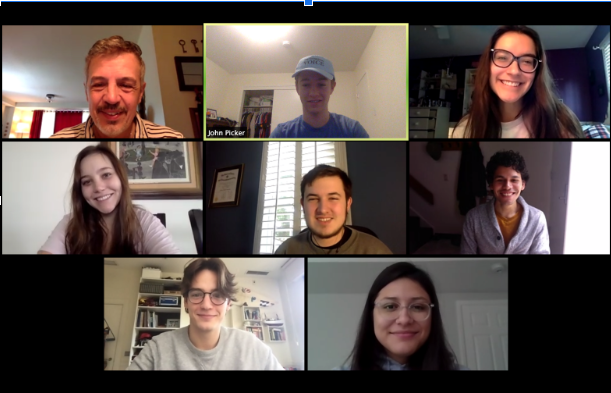
From top left: [Instructor: Giuseppe Tosi], John Picker, Natalia Lopez, Domenica Pratt, Harrison McBride, Edson Martinez, Umberto Sajonia Coburgo Gotha, Dulce Perez Briones.
Advanced Italian I and Advanced Italian for Spanish Speakers resumed online after spring break and followed the calendar that had been established at the beginning of the semester. Students participated with will and determination in the lessons and the performance of both courses was not particularly affected by the change to virtual learning.
In the Advanced I course, we created a new task that focused on the characteristics of an Italian industrial product with a strong historical and emotional identity, the Vespa Piaggio. The aim of the activity was to show how the iconography of the Vespa has been defined since the post-war years by a specifically Italian identity that has greatly contributed to its global success.

The most important point of Advanced Italian for Spanish Speakers course instead was a task on art that taught students how to interpret a work of art by following the canon established by art history scholars. The activity began with a technical and stylistic analysis of one of Caravaggio’s most famous works, La Conversione di Saul, and then developed through the inclusion of several works by other Italian and European Baroque painters of the seventeenth century.
Both tasks included a presentation for each student, and after an initial effort to adapt this kind of class activity to an online course, everything went smoothly, and all the presentations were successfully completed.

From top left: Natalie I., [Instructor: Donatella Melucci], Sophia E., Jason C., Kira R., Joanna L., Kelvia J., Samantha T., Chris P., Abriyanna F., Nadav S., Matthew R., Sarah C., Matthew L.
In Intensive Advanced Italian II the program continued as scheduled. We did everything possible to keep our lessons interactive and engaging as if we were in our classroom. We all are very impressed on how positively our students responded.
After Spring break students presented their projects on Italian history (1920-1950). Although the presentations were on Zoom, all students did an excellent job.

One of the tools we have been using to keep students engaged is a Google doc that we keep open during class where the instructor and the students write notes on the material covered and they use to complete individual and group activities. Of course students can access their class notes anytime after class to review. We found this way to share “class notes” so helpful and practical that we will keep using it when we resume face-to-face classes.
In Business Italian everything also proceeded as scheduled. Right after Spring Break, we had an interview via Zoom with Favini, an Italian company, a worldwide leader in the design and production of sustainable products such as natural fibers-based (cellulose, algae, fruits, nuts, leather, etc.), for the packaging of luxury and fashion industries. Since this interview was already planned to be via Zoom, we did not need to make any changes to our program.
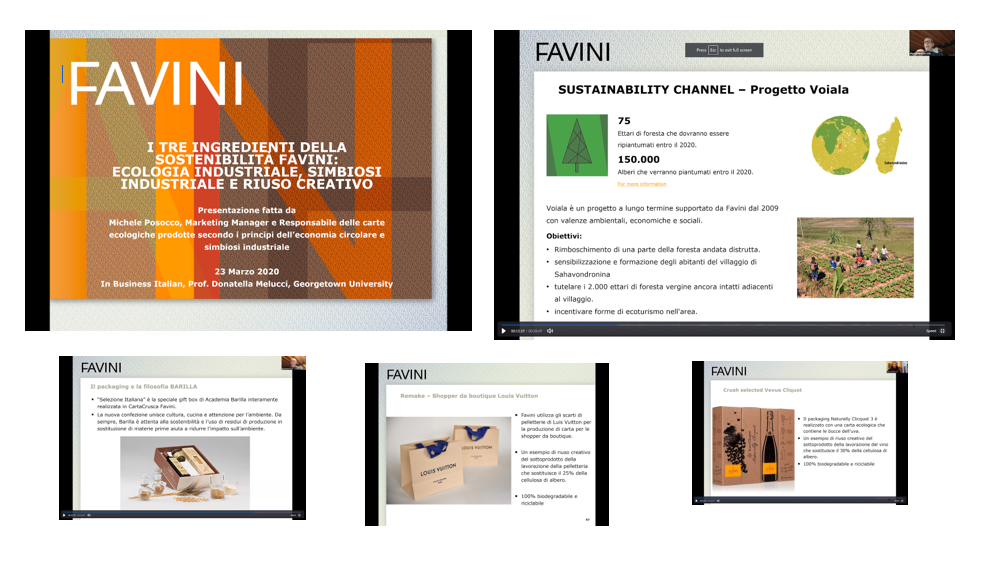

In general, a silver lining of this experience with remote teaching is that it helped us connect with our students on a different level. As we entered each other’s homes, some students introduced us to their families who expressed appreciation for what we are doing and we all were able to bring our pets to class.
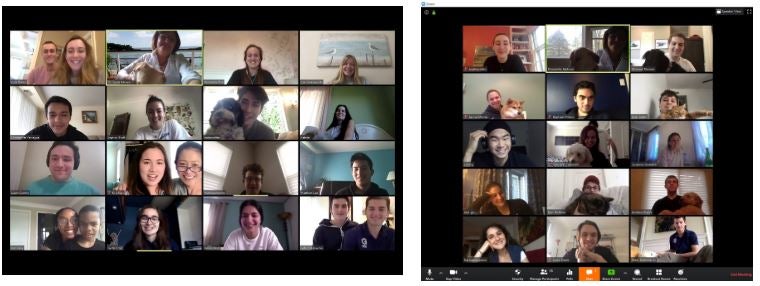
ITAL 042 – Gateway to Italian Culture
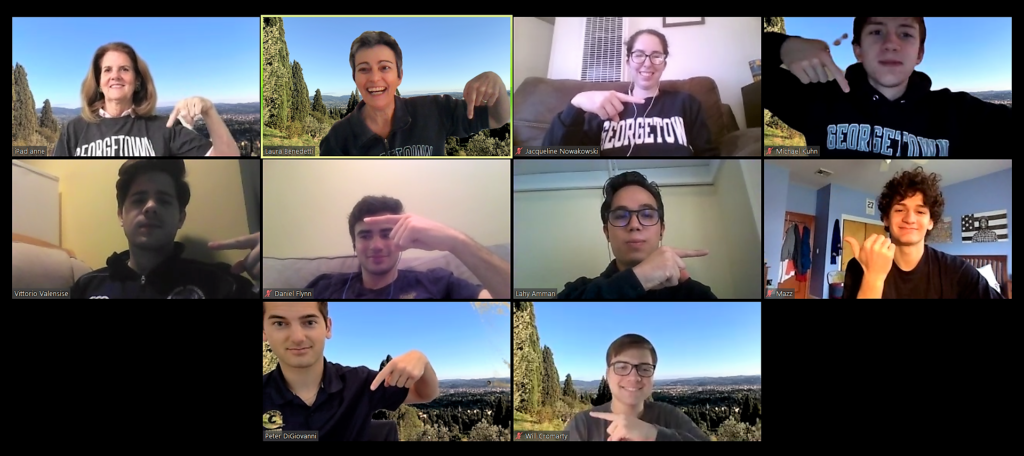
From top left: Anne Fontaine, Laura Benedetti (Instructor), Jacqueline Nowakowski, Michael Kuhn, Vittorio Valensise, Daniel Flynn, Lahy Amman, Michael Mazzariello, Peter DiGiovanni, William Cromarty.
After moving to a virtual learning environment, we not only continued our exploration of Italian culture from its origins to the present, but we also embarked on a common creative project. We were struck by the fact that there were ten people in the class—the same number as the storytellers in the Decameron, which takes place during the plague of 1348. We, therefore, decided to recreate a small and virtual version of Boccaccio’s work, which we named the Hoyasaxon. Each of us became queen or king for a day, chose a fictional identity, and told a story that best illustrates an issue relevant to our lives. It was a wonderful way to strengthen our community at a time when we were forced to stay apart. “If you ask me” one of the students wrote, “I think Boccaccio would be proud.”
ITAL 233 – Writing and Culture
As Italy has been at the forefront in the struggle against Covid-19, we added frequent updates on the situation in the country to our regular curriculum. In particular, we were fortunate to welcome on our screens Professor Enrico Botta (Università dell’Aquila), who on several occasions commented for us the latest developments and discussed a variety of issues, from the representation of diseases in literature to the role of the European Union in the recovery.
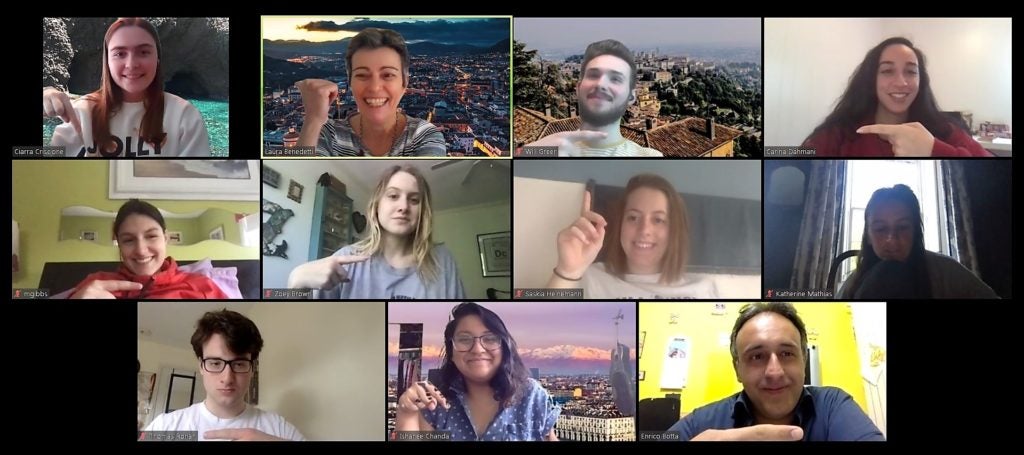
From top left: Ciarra Criscione, Laura Benedetti (Instructor), William Greer, Carina Dahmani, Maya Gibbs, Zoey Brown, Saskia Heinemann, Katherine Mathias, Thomas Ronan, Ishanee Chanda, Enrico Botta.
Italian Cinema (Ital 337) ….online.

Italian cinema (Instructor Gianni Cicali) went online. We explored Italian movies from Rossellini to Fellini, from Visconti to Pasolini, Petri, Giordana, Sorrentino, and many others with….share screen. I wish to thank (from top left) Luke, Harry, Cosmo, Serena, Isabelle, Olivia, Alessandra, Charles, Saskia, Claudia, and Sienna! I am the guy between Luke and Harry.
ITAL. /LING 444 Narrative, Discourse and Identity
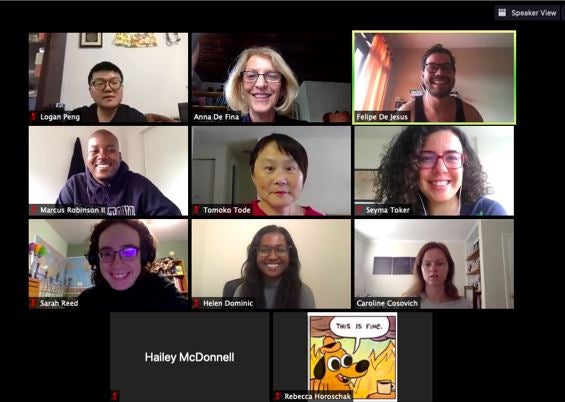
Students in Professor De Fina’s course on Narrative, Discourse and Identity continued studying digital stories collected before and after the Coronavirus lockdown. They took advantage of the breakout room function in Zoom to offer inspiring analyses of their data and to carry out animated discussions on how identities are constructed in the narrative.
